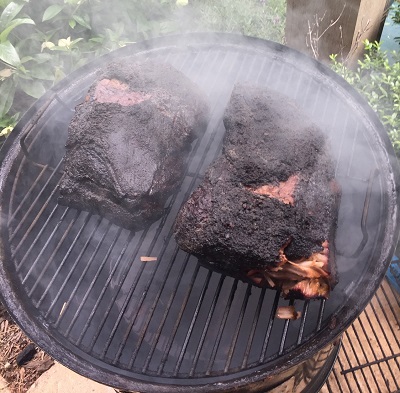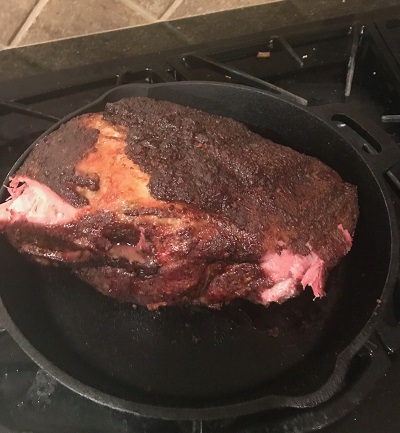When the last signs of winter finally fade, and the weather starts warming, the world is filled with new sights, sounds, and smells. The faint scent of chimneys is replaced by something sweeter wafting across the neighborhood. It’s backyard barbecue.
You know the smell. Somebody sets fire to charcoal. Before long, plumes of smoke start to rise. With it, aromas of hardwood burning. Hickory, or Apple, or Cherry. Next thing you know, you smell that meat cooking down the street.
And it smells good. Like maybe a little slice of heaven.
Or like maybe you want to finally introduce yourself to that neighbor who’s always got something cooking on his back deck. And find out how this backyard barbecuer does what he does. Forget the smells; how does he make it taste so good?
Find out from backyard barbecuer Jeff Osborne in this episode of the Low & Slow Barbecue Show. Jeff shares his success secrets for smoking Boston butt low and slow, as well as advice for a can’t lose backyard barbecue rub and Eastern Carolina vinegar-based barbecue sauce.
Keep reading for all the details on the backyard barbecue expert’s low and slow pedigree all the lowdown his backyard barbecue recipes.
Backyard Barbecue Family Tradition
Why does anybody start smoking pork over fire before serving it with sauce to crowds of hungry people? It’s not usually an accident. More often than not, in North Carolina, rich heritage is involved.
“As long as I can remember, I have been around a grill, been around a smoker,” Jeff says. “My grandfather was a butcher, and so my dad grew up around it, and that carried over into me. Growing up just watching my grandfather cooking, watching him master the grill at all the family functions.”
That mastery supported a side hustle catering business in the North Carolina Piedmont. For a butcher in North Carolina, where the pork industry’s economic impact tops $10 billion, it’s only natural that his catering business involves pork. And in the region around Greensboro, if there was pork smoking, it was prepared one way.
“Whole hog on a pit cooker, split down the middle, rib side up, skin side down. I remember watching him sit there and man it the whole time,” Jeff remembers, “and for me, this carries on to this day, once the meat is down, just sit back, and watch people enjoy it.”
Traditions like that aren’t hard to pass along, especially when it involves groups of people enjoying a good time. With a member of the Hickory Metro’s Mountain View Volunteer Fire Department in the home, a pig pickin’ with the fire department was a regular occasion.
“Our house was always the congregation point for my dad and all his friends, and the grill was always going. … Those always seemed to be a big fun gathering of people,” Jeff continues. “When I was a junior in high school, me and some buddies decided we’d throw a pick pickin’. We borrowed a cooker, bought the hog, seasoned it, sat there all night long in a big field, and cooked it up. Friends and party. Bonfire, all that good Southern stuff.”
Following in the footsteps of fathers before him, the backyard barbecue expert keeps the tradition alive in many ways.
Overnight Backyard Barbecue for the Tailgating Win

Meat smoking and backyard barbecue in the Carolinas is a four-season sport.
It doesn’t require anything fancy – nothing more than a bone-in pork shoulder, the Boston butt, one of the more inexpensive cuts of meat (often on sale for 99 cents a pound). Cook it in a simple smoker, low and slow all night long, and serve it up for any favorite function: college football tailgate, birthday party, graduation party.
Regardless of the reason, here’s what the process looks like for backyard barbecue, starting about dinner time the day before barbecue time.
1. Rub the Butt, No Binder
Allow an 8-10-pound butt to approach room temperature. Trim any excess fat if the cap is too thick. Remove any membrane skin and hard fat pieces – it doesn’t render down like the fat cap.
Apply a generous amount of rub seasoning (recipe below), and let the meat sit out and sweat. Flip the meat and repeat with the rub. Once the pork piece is rubbed, let it sit out while you prep the smoker.
(What? No binder? “I don’t use a binder. I go straight to the rub,” Jeff explains. “When you want a binder, like with mustard, if when you have 15-20 minutes before you need to put the meat on the smoker.”)
2. Minion Method & Hickory Smoke
Count on the backyard barbecue expert to have Kingsford charcoal. It is consistent and readily available in most grocery stores or hardware stores.
The minion method fills your smoker’s fire basket with unlit charcoal. Use additional charcoal to fill a charcoal chimney to start a clean fire (never use lighter fluid!). Once flames appear at the top of the chimney, dump the burning coals into the fire basket.
“The top layer of hot burning coals is going to slowly ignite the next layer of charcoal below, and it will light the next layer of unlit charcoal,” Jeff says. “You don’t have to have a full basket of flaming hot coals. It has one layer of flaming hot coals, then your next layer is getting hotter and hotter, and the fire is gradually spreading.”
Of course, the best place to find wood to complement your charcoal is … your backyard. Or your neighbor’s backyard.
“My preference is to find a Hickory tree, cut it into 2-3 inch disks, and let those age and dry out. Take an ax or hatchet and bust it into chunks, then soak that in water,” he says. “For me, Hickory and oak work the best for producing the kind of smoke I want. I stay away from mesquite. Soaking [the wood chips] will create the smoke you want in the smoker, but it doesn’t create more heat.”
3. Midnight Smoke while the Backyard Sleeps
Once your smoker reaches 225 degrees F and your meat has had a good sweat for a few hours, it is time for the midnight walk to the smoker. The meat will stay here for the next 16-18 hours.
“I like to get everything ready to go so that by midnight, I am putting the meat on. That way, it gives me all night,” Jeff says. “Everybody says if you’re looking, you’re not cooking.”
Using a consistent meat smoker that holds heat at 225 and relying on modern technology, the overnight cook isn’t the chore it once was.
“The tech is so great, you can set an alarm and be asleep in the bed. If the temp creeps up above 260, an alarm goes off. If it drops below 200, an alarm goes off, and I wake up,” he boasts. “But it doesn’t happen. I have a reliable system. You go to sleep, wake up the next morning and check on it.”
When you check on it, add more wood to keep the smoking coming. You won’t need to add more charcoal, but one thing to monitor after the overnight cook: the water pan.
Why? Be sure to listen to Jeff’s Man-cation Disaster on the River in this Low & Slow Barbecue Podcast episode.
4. Mop the Meat
First thing in the morning, you can start mopping the meat with your vinegar sauce (recipe below.) Hit the meat with the mop a couple of times on the first visit, once an hour after that.
“Some people spritz it; I prefer the mop,” Jeff says. “It goes back to the whole hog … that is how you get a lot of good flavor and moisture into the meat while it is cooking in the later stages.”
5. Is the Barbecue Ready Yet?
For an 8-10-pound Boston butt, the meat is servable any time after 10-12 hours. However, the next 6 hours of cooking render the fat down to give the meat flavor and fall-apart consistency. Once the bone in the pork shoulder is loose at the touch, you know the meat is tender – around an internal temperature of 205 degrees F.
“The last several hours of the cook, it is hard to keep the grill temp at 225. The longer and longer you get into the cook, and you get down to that last of the bed of coals, the grill temp and the meat temp kind of both come into a 200-205 range,” according to the backyard barbecue pro.
And no post-cook aluminum wrap for this barbecue entrée – as it might “give it a pot roast consistency.” Instead, let the meat rest for 15 minutes – that’s all – and then get ready to chop.
6. Serving Backyard Barbecue
“I have a huge cleaver and big cutting block, but really I like to shred it with my hands. Let the gloves keep the heat away, and get in there and pull the meat. It is so tender it shreds apart. I prefer that over chopped.”
Add vinegar sauce – even for someone in the Western part of North Carolina, the taste for the Eastern vinegar sauce is strong.
Buns?
“I put ‘em out,” he says. “I’m not really a big barbecue sandwich guy. When it is pulled and time to eat, for me, there is going to be 2-3 things on my plate: pulled pork, barbecue slaw – I love red slaw (recipe)– and sliced pickles.”
Complete the meal with baked beans and hushpuppies. Or not.
“The eating is just a small part of it,” he says. “The biggest part for me is sitting back and watching people enjoy it and drool and tell you how good the meat is.”
Backyard Recipe: Basic Carolina Sweet and Heat Barbecue Rub

Preparing the perfect pulled pork starts with the rub for the backyard barbecue expert. Season the meat generously, let the salt bring forth juices, and begin osmosis, sending flavor back into the pork shoulder.
Using a ratio of 6:3:2:2:1, a meat-smoking novice can prepare the backyard barbecue rub in any quantity. For the sake of simplicity, I measure in cups.
Carolina Sweet Heat Rub
6 cups brown sugar
3 cups fresh ground pepper
2 cups kosher salt
2 cups garlic powder
1 cup cayenne pepper
Importantly using freshly ground black pepper makes a difference.
“I buy fresh peppercorns and use a coffee grinder to crush the pepper corns,” Jeff says, compaing the pepper grind to the beans in a morning brew. “You grind a whole bean of coffee, you open up the flavors. Same thing with fresh ground coarse pepper.”
And with a coffee grinder, don’t go for a fine grind. Focus on a finish with thicker, bigger chunks of pepper corn.
Backyard Barbecue Mop Recipe
For backyard barbecuer Jeff Osborne, one of the biggest secrets to a perfect pulled pork is the mop and dip sauce.
“I picked this up from my grandfather watching him years ago,” Jeff says. “It is so simple but so classic.”
Eastern Carolina Barbecue Mop
1 gallon apple cider vinegar
Half stick of butter
1/2 cup crushed red pepper flakes
Texas Pete to taste.
Heat the vinegar to melt in the butter, then let it cool. Retain the liquid your gallon cider jug. Pour a small amount into a smaller container and use a mop or brush to apply mop to the meat hourly following the first 10 hours of cooking.
Leftover liquid vinegar concoction serves as a sauce offered on the side.
“My favorite method for eating is taking a chunk of pulled pork and dipping it in the vinegar sauce and eating it,” directs the backyard barbecue expert.
Get the Complete Backyard Barbecue Lowdown
Backyard barbecue expert Jeff Osborne shares more tips for best barbecue practices in the Low & Slow Barbecue Show. Listen today for the complete dish on the best – and worst – barbecue he has ever prepared.
Listen now for BBQ 101 tips for making sure your smoker is set right for low and slow output. Don’t miss Jeff’s opinion on the best state for barbecue – and the best places to find that “best” barbecue.
About the Author

Smoked meat, barbecue enthusiast, news journalist, and sports radio broadcaster Michael “Chigger” Willard collects a storybook of life captured through the lens of people he encounters. With a perspective seasoned by small town life in the Deep South, he dedicates conversations to uncovering savory nuggets of information, light-hearted moments of humor, and revealing glimpses of humanity.
Want more?
- Podcast Episodes
- Barbecue Blogs
- BBQ News & Recipes
Subscribe to The Lowdown BBQ Newsletter!


